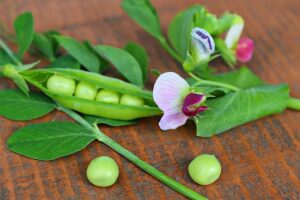Introduction

Nitrogen-fixing plants play a seminal role in enriching soil fertility and promoting a lush, thriving garden. They have a unique symbiotic relationship with bacteria such as rhizobia, which inhabit the root nodules of the plants and convert atmospheric nitrogen into a form that can be assimilated by plants. This process of biological nitrogen fixation not only minimizes the dependency on synthetic fertilizers but also contributes to maintaining a healthy nutrient cycle in the soil ecosystem.
Definition of Nitrogen-Fixing Plants
Nitrogen-fixing plants are unique species capable of converting atmospheric nitrogen, which is inaccessible to most living organisms, into a form that plants can utilize—ammonia. They do this with the help of symbiotic bacteria in their root nodules, thus playing a vital role in the nitrogen cycle.
The Importance of Nitrogen in Plant Growth
Nitrogen is a critical nutrient for plants, being a significant component of chlorophyll, the substance by which plants convert sunlight into energy via photosynthesis. Furthermore, nitrogen is a major part of amino acids, the building blocks of proteins. Without a sufficient supply of nitrogen, plants cannot grow and thrive.
Description of Nitrogen Fixation
Nitrogen fixation is a biological process where atmospheric nitrogen (N2) is transformed into ammonia (NH3). This conversion is crucial because most plants cannot directly utilize atmospheric nitrogen. Ammonia, being a more reactive compound, is readily absorbed and used by plants for their protein synthesis, DNA construction, and chlorophyll formation.
Role of Microorganisms in Nitrogen Fixation
The conversion of nitrogen into a form usable by plants is primarily achieved by certain microorganisms, often referred to as diazotrophs. These nitrogen-fixing bacteria often live symbiotically with plants, residing in specialized structures called nodules in the roots of the plants. The most common of these bacteria belong to the genus Rhizobium, which forms symbiotic relationships with leguminous plants. These bacteria convert the atmospheric nitrogen to ammonia, which the plant then utilizes. In return, the plant provides the bacteria with carbohydrates and a protected environment, making it a mutualistic relationship.
Types of Nitrogen-Fixing Plants
Legumes
Legume plants are known for their nitrogen-fixing abilities, largely due to their symbiotic relationship with Rhizobium bacteria. These plants, which include peas, lentils, alfalfa, and clover, have root nodules where the bacteria reside. The bacteria convert atmospheric nitrogen into ammonia, which the legume plants can then use for their growth and development.
Non-Legumes
While legumes are the most well-known nitrogen-fixing plants, certain non-legume plants can also fix nitrogen. These include species like Alder trees, Casuarina, and Myrica, which partner with Frankia bacteria for nitrogen fixation. Similarly, Azolla ferns have a symbiotic relationship with Anabaena, a cyanobacterium, for nitrogen fixation. These non-leguminous nitrogen-fixing plants play a vital role in enriching soil fertility, particularly in ecosystems where legumes are not present.
Importance of Nitrogen-Fixing Plants
Improvement of Soil Fertility
Nitrogen-fixing plants contribute significantly to soil fertility. Through their unique nitrogen fixation process, these plants can convert atmospheric nitrogen into forms that are usable by other plants. This increases the nitrogen levels in the soil, thereby improving its fertility and promoting healthy plant growth.
Reduction of the Need for Chemical Fertilizers
With their inherent ability to fix atmospheric nitrogen, these plants reduce the need for chemical fertilizers. They provide a natural, sustainable, and eco-friendly solution to enriching soil nitrogen content, thereby minimizing the reliance on chemical fertilizers that can cause environmental harm.
Contribution to Ecosystem Balance
Nitrogen-fixing plants play a crucial role in maintaining ecosystem balance. They enrich the soil with essential nutrients, promoting the growth of diverse plant species. This plant diversity, in turn, supports a wide range of fauna, contributing to a balanced and biodiverse ecosystem.
Examples of Nitrogen-Fixing Plants
Clovers
Clovers, also known as Trifolium, are one of the most common examples of nitrogen-fixing plants. Distributed widely across the world, clovers can fix nitrogen due to their symbiotic relationship with Rhizobium bacteria. These plants not only enrich the soil but also serve as nutritious fodder for livestock.
Peas
Peas, scientifically known as Pisum sativum, are another well-known nitrogen-fixing plant. They form a symbiotic relationship with Rhizobia bacteria, which enables them to fix nitrogen. Peas are not only important for soil fertility but also provide nutritional benefits as they are rich in protein and fiber.
Alfalfa
Alfalfa, or Medicago sativa, is a deep-rooted perennial plant that can fix a significant amount of nitrogen, making it an excellent choice for improving soil fertility. It forms nodules with Sinorhizobium meliloti bacteria that aid in nitrogen fixation. Additionally, alfalfa is commonly used as a high-protein feed for livestock.
Soybeans
Soybeans, known scientifically as Glycine max, are an excellent source of nitrogen fixation. They enter into a symbiotic relationship with Bradyrhizobium japonicum bacteria to aid in the process. Apart from their role in improving soil fertility, soybeans are a crucial crop globally due to their high protein content and versatility in various food products.
Lupins
Lupins, belonging to the genus Lupinus, are remarkable nitrogen-fixing plants. They establish a mutual relationship with Bradyrhizobium bacteria for nitrogen fixation. These plants not only enhance soil nitrogen content but are also grown for their ornamental value due to their vibrant flowers.
Beans
Beans, from the Phaseolus genus, also contribute to nitrogen fixation. They interact with Rhizobia bacteria, which assist in the nitrogen-fixing process. In addition to boosting soil fertility, beans are a staple food crop worldwide, noted for their high protein content and dietary fiber.
Application of Nitrogen-Fixing Plants in Farming and Home Gardening
Nitrogen-fixing plants hold significant potential in both farming and home gardening due to their ability to improve soil fertility and promote a healthier, more sustainable ecosystem.
In farming, these plants can be used in a crop rotation system. For instance, planting clovers or peas in a field after harvest can replenish the soil’s nitrogen content for the next planting season, reducing the need for synthetic fertilizers. This approach not only improves soil health but also leads to better crop yields and lower input costs, making farming more sustainable and economically viable.
For home gardeners, nitrogen-fixing plants offer an organic, eco-friendly solution to maintaining soil health. Incorporating plants like alfalfa, peas, or clovers into your garden can enhance the soil’s nutrient profile, promoting the growth and vitality of other plants in your garden. Additionally, these crops can be used as cover crops in the home garden beds. Many of these nitrogen-fixing species are aesthetically pleasing and can contribute to the overall visual appeal of your garden while supporting a healthier environment.
How to Use Nitrogen-Fixing Plants as Cover Crops in Home Garden Beds
Using nitrogen-fixing plants as cover crops in your home garden beds is a simple and efficient way to improve soil fertility. Begin by choosing the right plant for your garden. Alfalfa, clover, and peas are all excellent options. These plants not only replenish the soil with necessary nitrogen but also add organic matter that improves soil structure and water-holding capacity.
To plant, first, clear your garden bed of any existing plants or weeds. Spread the seeds of your chosen nitrogen-fixing plant evenly across the surface of the soil. Then lightly rake the soil to cover the seeds. Water the area well.
Allow the cover crops to grow through the season. When they start to flower, cut them down and leave the plant matter on the surface of the soil. This acts as a green mulch and as it decomposes, it releases the nitrogen back into the soil, ready for your next planting.
Remember, the key to successful use of cover crops is rotation. Rotate your cover crops with other plants in your garden to maintain balanced soil fertility and prevent any one species from dominating.
Alternatives to Nitrogen-Fixers
There are other methods of replenishing soil nitrogen besides using nitrogen-fixers. For instance, you can use compost or commercial fertilizers to introduce nitrogen into the soil for your plants. Composting food scraps and other organic materials is an excellent way of creating a nutrient-rich fertilizer that you can use in your garden. Commercial fertilizers are also available, though they tend to be more expensive than other methods.
No matter which method you choose, it’s essential to test the pH of your soil regularly and adjust it if necessary. A balanced pH will ensure that plants in your garden have access to the right nutrients to grow strong and healthy.
Sustainability is an important concept for any gardener, and implementing nitrogen-fixing plants into your rotation is a great way to ensure the long-term success of your garden. With a little research and planning, you can create an optimal environment for your plants to thrive!
Finally, don’t forget to take care of yourself and your family while gardening. Wear sun protection, stay hydrated, and wear gloves when handling soil or organic matter. Gardening should be
Conclusion
Nitrogen-fixing plants are an important part of a healthy garden. By including them in your regular rotation of plants, you can ensure that your soil remains fertile and is able to support the growth of other species in your garden. This will help keep your garden lush, vibrant, and beautiful for years to come.
By understanding how nitrogen-fixing plants can benefit your garden and following the steps outlined above, you can easily add these essential plants to your garden beds. You’ll be amazed at how quickly their benefits take effect!
Using cover crops is just one step you can take to ensure the sustainability of your home garden. Other sustainable practices include composting kitchen waste for a rich fertilizer and reducing water runoff from your property. With a few simple changes, you can help make sure that your garden remains healthy and productive for years to come.
Take the time to learn more about sustainable gardening practices today – it’s an investment in the future of our planet!
For other gardening topics click here.

